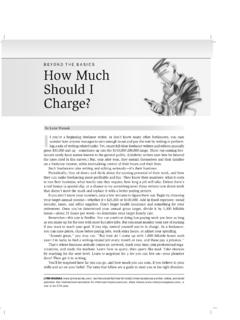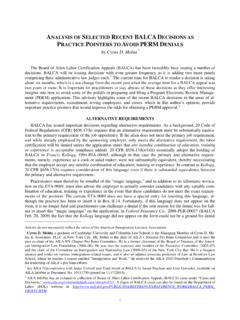Transcription of NaNoWriMo Cheat Sheet: Character Development Worksheets
1 Week 191 NaNoWriMo Cheat sheet : Character Development Worksheets by Victoria Lynn Schmidt, s DigestWeek 192 Character Worksheets the Mighty oak was once a little nut that held its ground. anonymousoBJeCtIVeS Create a Character Story Sketch to help you remember little de-tails about all of your characters. Create Character Snapshots for your main characters that help you to add depth to them. Think through your Character -Revealing Scenes in order to have interesting scenes ready that you know will reveal deeper aspects of your characters. DeVeLoP YoUr CHaraCterS While the Book in a Month (BaIM) 30-day plan is all about getting down the plot (that s why we do the plot outline first), characterization is still extremely impor-tant. It doesn t matter if you are writing a Character -driven story or a plot-driven one; the plot is still what you are focusing on when writing quickly.
2 Character -driven pieces just have the characters driving the plot forward. Many writers like to map out their characters before they start writing, while others like to wait until they have written a little of the story and gotten to meet their characters before mapping them out. the following Worksheets represent a middle ground of sorts allowing you to think through certain aspects without going too deep too early in the writing process. What I have created here are three distinct Worksheets that will help you get to know your charac-Week 193ters better and help you plan for and chart their growth throughout your story: Character Story Sketch: this worksheet helps to bring out those elements that relate to the plot as well as the standard biographi-cal elements. For example: Sara is a tall brunette with a few ex-tra pounds and whole lot of confidence.
3 Character Snapshot: this worksheet provides a quick overview of your main characters and expands on the story sketch infor-mation, revealing more depth about the psychology of each char-acter. Under trauma, for instance, you might write: Sara was abused as a child. Character -Revealing Scenes: this worksheet allows you to out-line the possible scenes that will reveal each of the categories in the Character Story Sketch and Character Snapshot work-sheets regarding the main characters. (You can use the scenes you have listed in your outline if you want to and add elements to reveal the main characters.) For example, a scene that relates to the Character s trauma might be: Sara watches as the woman in the store hits her daughter. Her muscles tighten. She just can t contain herself, not after what she went through as a child. No. She has to speak up!
4 Do you see how this works? Create a Character Story Sketch to get a handle on the basics of who a Character is. Use that information to go a little deeper and come up with a more precise Character Snapshot. then use the information from your Character Snapshot to complete the Character -revealing Scenes worksheet by taking each topic area from the snapshot to come up with different scenes to reveal this in-formation. In each box, write a possible scene you could have to reveal the main Character . You don t have to use these scenes, but if and when Week 194you get stuck, you will have some great scenes to fall back on. Let s say that as you brainstorm for the Psychology/trauma sec-tion of the Character Snapshot, you decide your heroine was attacked by a dog as a kid. When you get to the Character -revealing Scenes work- sheet , you can choose to write in the Scenes to reveal trauma section: When the heroine tries to confront the villain in act II, a large dog wanders into her view and she freezes in silent panic, giving the villain a chance to , isn t that a much better way to give the villain a chance to es-cape than just arbitrarily having the villain escape by some other means?
5 This way, you have come up with something that also reveals a bit about the heroine in the process. How do you think she will feel af-ter he gets away now? Much worse than if she really tried to stop him and he got away without any real fault or failure of her own. or you could write in the Scenes to reveal trauma section:If needed, the heroine could be forced to confront several guard dogs to fulfill her objective or achieve a secondary you find you need something to keep the story moving forward, you can look at the Character -revealing Scenes worksheet and decide to add a guard dog to the scene and spice it up a bit. think about Harrison Ford as Indiana Jones and how his Character can t stand snakes. It really adds a lot to several scenes when he must do something to save someone s life while confronting his fear of snakes at the same time. It also helps make his Character feel more human.
6 Week 195 Character StorY SketCHStorY tItLeCHaraCter NaMeageethnicityHeightWeightHaireyeseduc ationresidenceJobarchetypeBirth SignreligionStyle of DressDistinguishing MarksFaVorIte tHINgSMusicFoodColorPastimeentertainment JUSt tHe FaCtSChildrenPetsHobbiesWeek 196 Family SecretsWorst Feargreatest HopeSkillsPrized PossessionVulnerabilityregretsgeneral outlookgoINg DeePerDescribe the first impression this Character how and why other characters view this what this Character needs to learn by the end of the how you will foreshadow this ending in the story s 197 Character SNaPSHotV I taL S tatIS t I C SNameNationalityageFamily SituationappearanceQuirksPSYCHoLogYtraum asWeek 198 Feelings about Settingsoverall attitudeFearsJoysaCCoMPLISHMeNtSSkillsWe aknessesawards/DegreesDreams/ambitionsWe ek 199 MotIVatIoNStop PrioritiesFavorite things/PeopleobsessionsguiltsCHaraCter arCLessons to LearnIntended Character ChangesIMPortaNt NoteS to reMeMBerWeek 1100 Note: remember that you have in your story not just a protagonist, whose goal is shaped or informed by who he is and where he s been, but you have an antagonist, whose goal is in conflict with that of your main Character .
7 At the moment, having a clear understanding of what your villain s goal is will be enough to keep your story moving in the right direction. But as you write, you ll come to understand more of who your villain is and what parts of his own life have pushed him toward this goal. rather than trying to map out the villain s upbringing, likes and dislikes, or per-sonal tragedies now, taking up valuable writing time, keep a blank Character sheet handy and make notes to yourself as more of your villain is revealed to you. Character -reVeaLINg SCeNeSScenes to reveal appearance:Scenes to reveal quirks:Scenes to reveal Character s lesson:revealing scenes for:Scenes to reveal skills/weaknesses:Scenes to reveal motivation:Scenes to reveal trauma:For more great advice on how to write a novel in 30 days, check out Book in a Month: the Fool-Proof System for Writing a Novel in 30 Days









